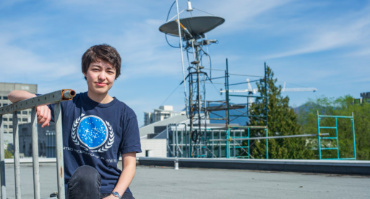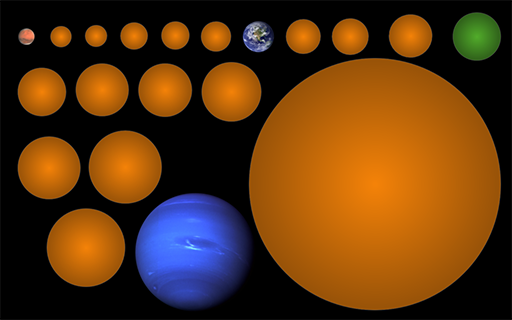UBC student discovers 17 new planets, including potentially habitable, Earth-sized world

(From UBC News) University of British Columbia astronomy student Michelle Kunimoto has discovered 17 new planets, including a potentially habitable, Earth-sized world, by combing through data gathered by NASA’s Kepler mission.
Over its original four-year mission, the Kepler satellite looked for planets, especially those that lie in the “Habitable Zones” of their stars, where liquid water could exist on a rocky planet’s surface.
The new findings, published in The Astronomical Journal, include one such particularly rare planet. Officially named KIC-7340288 b, the planet discovered by Kunimoto is just 1 ½ times the size of Earth – small enough to be considered rocky, instead of gaseous like the giant planets of the Solar System – and in the habitable zone of its star.
“This planet is about a thousand light years away, so we’re not getting there anytime soon!” said Kunimoto, a PhD candidate in the department of physics and astronomy. “But this is a really exciting find, since there have only been 15 small, confirmed planets in the Habitable Zone found in Kepler data so far.”
The planet has a year that is 142 ½ days long, orbiting its star at 0.444 Astronomical Units (AU, the distance between Earth and our Sun) – just bigger than Mercury’s orbit in our Solar System, and gets about a third of the light Earth gets from the Sun.
Of the other 16 new planets discovered, the smallest is only two-thirds the size of Earth – one of the smallest planets to be found with Kepler so far. The rest range in size up to eight times the size of Earth.
“Every time a planet passes in front of a star, it blocks a portion of that star’s light and causes a temporary decrease in the star’s brightness,” Kunimoto said. “By finding these dips, known as transits, you can start to piece together information about the planet, such as its size and how long it takes to orbit.”

Kunimoto also collaborated with UBC alumnus Henry Ngo to obtain razor-sharp follow-up images of some of her planet-hosting stars with the Near InfraRed Imager and Spectrometer (NIRI) on the Gemini North 8-metre Telescope in Hawaii.
“I took images of the stars as if from space, using adaptive optics,” she said. “I was able to tell if there was a star nearby that could have affected Kepler’s measurements, such as being the cause of the dip itself.”
In addition to the new planets, Kunimoto was able to observe thousands of known Kepler planets using the transit-method, and will be reanalyzing the exoplanet census as a whole.
“We’ll be estimating how many planets are expected for stars with different temperatures,” said Kunimoto’s PhD supervisor and UBC professor Jaymie Matthews. “A particularly important result will be finding a terrestrial Habitable Zone planet occurrence rate. How many Earth-like planets are there? Stay tuned.”
Media Contact
Sachi Wickramasinghe
UBC Media Relations
Tel: 604-822-4636
Cel: 604-754-8289
Email: sachi.wickramasinghe@ubc.ca
Media Coverage
- Star search leads UBC astronomy student to 17 previously unidentified planets (Vancouver Sun, February 28 2020)
- Una estudiante localiza un pequeño mundo distante en zona habitable (EuropaPress, February 28 2020)
- This astronomy student found 17 new exoplanets -- and one is potentially habitable (CNN, February 28 2020)
- Will All These Young People Stop Discovering Potentially Habitable Exoplanets Already? (Popular Mechanics, February 28 2020)
- An astronomy student found 17 new exoplanets — and one is potentially habitable (FOX8, February 28 2020)
- STUDENT DISCOVERS 17 PLANETS, ONE OF WHICH COULD HOST LIFE (Futurism, February 28 2020)
- Una estudiante estadounidense de 23 años descubre 17 planetas, uno similar a La Tierra (rtve, February 28 2020)
- UBC astronomy student discovers 17 new planets (Daily Hive, February 28 2020)
- Star search leads UBC astronomy student to 17 previously unidentified planets (The Province, February 28 2020)
- UBC student discovers 17 new planets – including 1 in habitable zone (KelownaNow, February 28 2020)
- UBC student discovers 17 new planets (News 1130, February 28 2020)
- UBC graduate student finds 17 new planets, one potentially Earth-like (Global News, February 28 2020)
- Seventeen new planets, including one Earth-sized world discovered (The Economic Times, February 28 2020)
- Planet-hunting astronomy student discovers 17 new worlds including one that is Earth-sized, rocky and potentially habitable using data from the Kepler Space Telescope (Daily Mail, February 28 2020)
- Who is Michelle Kunimoto? University of British Columbia student found 17 new exoplanets (International Business, February 29, 2020)
- UBC astronomy student finds 17 new possible planets, 1 may have water (CBC News, March 1, 2020)
- UBC student discovers 17 new exoplanets, including a 'Super-Earth' (Yahoo News, March 2 2020)
- Astronomy PhD Student at UBC discovers 17 new potential planets (Radio Canada, March 2 2020)
- &UBC student discovers new planet that might hold liquid water one thousand light years from Earth (Georgia Straight, March 2 2020)
- Astronomy student discovers 17 new planets (New York Post, March 2 2020)
- UBC student discovers 17 alien worlds. One may be capable of hosting life! (The Weather Network, March 3 2020)
- Student discovers 17 new planets (Gadgets, March 3 2020)
- She’s Discovered More Planets Than You Have (Research2Reality, March 26 2020)